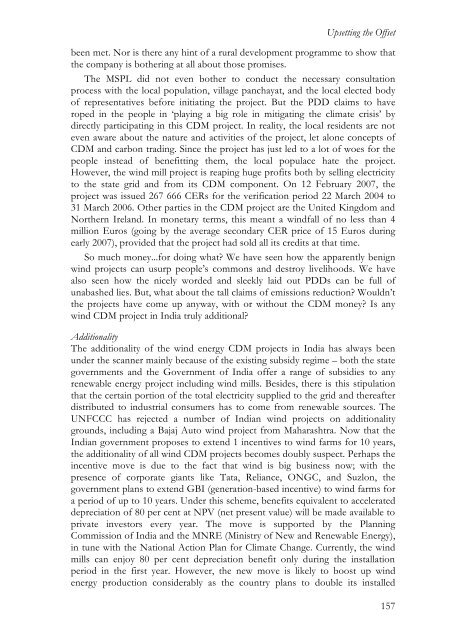Upsetting the Offset - Transnational Institute
Upsetting the Offset - Transnational Institute
Upsetting the Offset - Transnational Institute
You also want an ePaper? Increase the reach of your titles
YUMPU automatically turns print PDFs into web optimized ePapers that Google loves.
<strong>Upsetting</strong> <strong>the</strong> <strong>Offset</strong><br />
been met. Nor is <strong>the</strong>re any hint of a rural development programme to show that<br />
<strong>the</strong> company is bo<strong>the</strong>ring at all about those promises.<br />
The MSPL did not even bo<strong>the</strong>r to conduct <strong>the</strong> necessary consultation<br />
process with <strong>the</strong> local population, village panchayat, and <strong>the</strong> local elected body<br />
of representatives before initiating <strong>the</strong> project. But <strong>the</strong> PDD claims to have<br />
roped in <strong>the</strong> people in ‘playing a big role in mitigating <strong>the</strong> climate crisis’ by<br />
directly participating in this CDM project. In reality, <strong>the</strong> local residents are not<br />
even aware about <strong>the</strong> nature and activities of <strong>the</strong> project, let alone concepts of<br />
CDM and carbon trading. Since <strong>the</strong> project has just led to a lot of woes for <strong>the</strong><br />
people instead of benefitting <strong>the</strong>m, <strong>the</strong> local populace hate <strong>the</strong> project.<br />
However, <strong>the</strong> wind mill project is reaping huge profits both by selling electricity<br />
to <strong>the</strong> state grid and from its CDM component. On 12 February 2007, <strong>the</strong><br />
project was issued 267 666 CERs for <strong>the</strong> verification period 22 March 2004 to<br />
31 March 2006. O<strong>the</strong>r parties in <strong>the</strong> CDM project are <strong>the</strong> United Kingdom and<br />
Nor<strong>the</strong>rn Ireland. In monetary terms, this meant a windfall of no less than 4<br />
million Euros (going by <strong>the</strong> average secondary CER price of 15 Euros during<br />
early 2007), provided that <strong>the</strong> project had sold all its credits at that time.<br />
So much money...for doing what? We have seen how <strong>the</strong> apparently benign<br />
wind projects can usurp people’s commons and destroy livelihoods. We have<br />
also seen how <strong>the</strong> nicely worded and sleekly laid out PDDs can be full of<br />
unabashed lies. But, what about <strong>the</strong> tall claims of emissions reduction? Wouldn’t<br />
<strong>the</strong> projects have come up anyway, with or without <strong>the</strong> CDM money? Is any<br />
wind CDM project in India truly additional?<br />
Additionality<br />
The additionality of <strong>the</strong> wind energy CDM projects in India has always been<br />
under <strong>the</strong> scanner mainly because of <strong>the</strong> existing subsidy regime – both <strong>the</strong> state<br />
governments and <strong>the</strong> Government of India offer a range of subsidies to any<br />
renewable energy project including wind mills. Besides, <strong>the</strong>re is this stipulation<br />
that <strong>the</strong> certain portion of <strong>the</strong> total electricity supplied to <strong>the</strong> grid and <strong>the</strong>reafter<br />
distributed to industrial consumers has to come from renewable sources. The<br />
UNFCCC has rejected a number of Indian wind projects on additionality<br />
grounds, including a Bajaj Auto wind project from Maharashtra. Now that <strong>the</strong><br />
Indian government proposes to extend 1 incentives to wind farms for 10 years,<br />
<strong>the</strong> additionality of all wind CDM projects becomes doubly suspect. Perhaps <strong>the</strong><br />
incentive move is due to <strong>the</strong> fact that wind is big business now; with <strong>the</strong><br />
presence of corporate giants like Tata, Reliance, ONGC, and Suzlon, <strong>the</strong><br />
government plans to extend GBI (generation-based incentive) to wind farms for<br />
a period of up to 10 years. Under this scheme, benefits equivalent to accelerated<br />
depreciation of 80 per cent at NPV (net present value) will be made available to<br />
private investors every year. The move is supported by <strong>the</strong> Planning<br />
Commission of India and <strong>the</strong> MNRE (Ministry of New and Renewable Energy),<br />
in tune with <strong>the</strong> National Action Plan for Climate Change. Currently, <strong>the</strong> wind<br />
mills can enjoy 80 per cent depreciation benefit only during <strong>the</strong> installation<br />
period in <strong>the</strong> first year. However, <strong>the</strong> new move is likely to boost up wind<br />
energy production considerably as <strong>the</strong> country plans to double its installed<br />
157
















